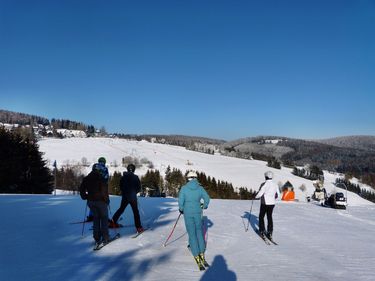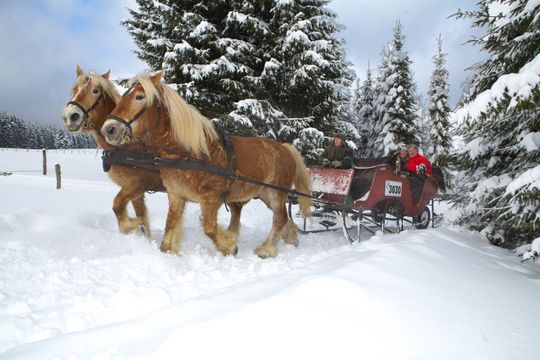Winterberg is the highest town in North Rhine-Westphalia. It often gets a lot of snow in the winter – otherwise, snow cannons can be used. No wonder it’s a popular destination for winter sports enthusiasts. Here you can go skiing, sledging, hiking – perfect for a weekend trip.
About the region
The health-resort town of Winterberg is located in the Sauerland region of North-Rhine Westphalia (NRW). It is a popular destination among winter sports lovers. It boasts the largest interconnected ski area north of the Alps.
Winterberg is also an Olympic training centre for bobsleigh and skeleton, and a national training centre for young athletes in biathlon and Nordic ski disciplines. You’ll find many athletes here preparing for competitions under professional supervision. That’s why Winterberg occasionally hosts world and European winter sport championships. Sometimes, it gets more than 900,000 visitors in one winter season.
Make the most of Winterberg in two days
Day 1: Friday (winter sports)
The best way to get to Winterberg is by train. You can find more information here.
Before you head up the mountain, you should drop off your luggage. The is a good place to stay as it is relatively close to a ski area.
Once you’ve offloaded your things and put on your ski wear, your winter adventure can begin. The ski village Neuastenberg-Postwiese is situated just 300 metres away from the youth hostel, so you can get there on foot. The mountain offers 16 slopes open every day from 9 am to 4:30 pm until the beginning of March. Students receive a concession. So don’t forget your student ID!
is a ski hire store located near the youth hostel. Here you can rent equipment, such as skis, snowboards and even sledges. To be on the safe side, you should also hire a ski helmet. If you are not a confident skier, you can sign up for a ski course at the rental store.
Around lunch time, you can take a break and get a bite to eat in the ski village before heading for the slopes again. But don’t worry, you don’t have to trudge up the mountain – you can get pulled up with the tow lift.
When darkness falls, it’s time to switch your skis for a sledge. Between 6:30 pm and 9:30 pm, you can whizz down the illuminated natural sledding run. The sledding run in the ski village is the only one of its kind in the Sauerland region. The 500-m course loops around two long bends along forest trails. They also have an extra lift here that will take you and your sledge back up to the top.
If you still have any energy to spare, you can go to après-ski parties in the ski village, for example, at the Lawine, a bar on the route to the youth hostel. By the way, people always wear their ski suits to après-ski. You don’t have to get dressed up.
Day 2: Saturday (sightseeing)
Day 2 in Winterberg gets off to a more relaxing start. The first item on the agenda is a visit to the . You can get there from the youth hostel by taking the bus R28 or the SkiBus toward Winterberg/Bahnhof. Get off at the Winterberg/Pforte bus stop. Take the R48 bus toward Düdinghausen/Kirche until you get to the Elkeringhausen/Am Knittenberg stop. From there, the SalzGrotte is just a few metres down the road on your left.
The grotto looks like a natural cave, but it’s actually manmade. The walls and floor are completely made of salt. Since you have to take off your shoes, make sure to bring along some thick socks. But don’t worry about getting cold feet because they keep the grotto at a cosy 20 °C. You can lie back on a deck chair, listen to relaxing music and inhale the salty mist – which is said to be very healthy. To avoid unnecessary waiting, you can make an advance appointment by e-mail or phone.
After your visit to the grotto, the next stop is the Kahler Asten. At an elevation of 842 metres, it’s the second highest peak in NRW. From the bus stop Am Knittenberg, take the R48 back to the stop Pforte. On Saturdays, the express bus 40 runs an hourly service in the direction of Grafschaft. Get off at the stop Nordhang and take the taxi bus to the Kahler Asten. You have to order the taxi bus in advance by ringing: 0 800 3 50 40 31. When you reach the top, you’re in for a breathtaking view. You can get even better ones from the observation tower. On the summit, the German Weather Service also operates a weather station and an info centre about weather and the climate.
Get ready for more physical activity – on a hike along the winter hiking trails. One of the trails begins and ends at the observation tower. The round-trip hike is rated as easy so even first-time winter hikers won’t find it too difficult. The route is cleared of snow and is only 1.2 km long. But you should wear boots with good traction. Simply follow the trail markers and enjoy the snowy landscape.
By now your stomach must be rumbling. You can get lunch at either the Berggasthof or the Turmrestaurant. The Berggasthof mainly serves hearty meals, such as homemade soup – great for thawing out frozen limbs! But there’s also curried sausage. Once you have eaten, you can travel back to Winterberg.



